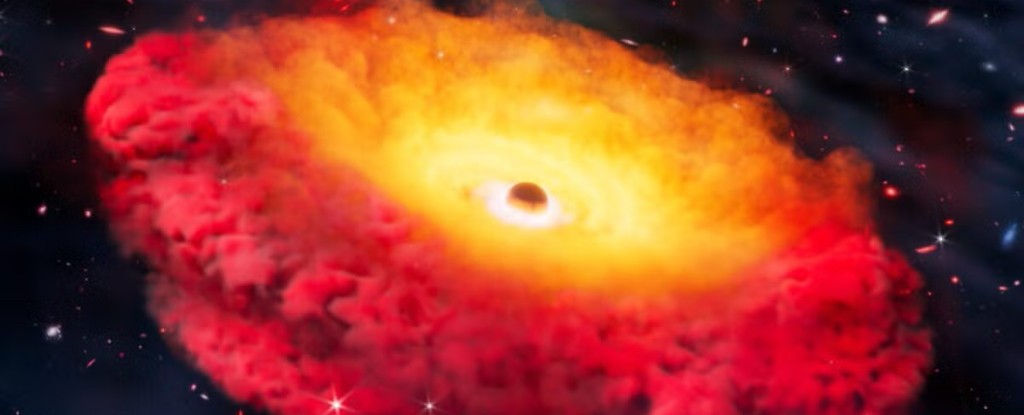
Astronomers have made a groundbreaking discovery by confirming the earliest and most distant black hole to date, located in the galaxy known as CAPERS-LRD-z9. This enormous black hole, with a mass of approximately 300 million solar masses, formed just 500 million years after the Big Bang, when the universe was merely 3 percent of its current age. This finding not only highlights the black hole’s immense size but also provides insights into a puzzling class of celestial objects referred to as Little Red Dots (LRDs).
These mysterious LRDs emerged around 600 million years following the Big Bang and began to disappear less than a billion years later. Recent advancements from the James Webb Space Telescope (JWST) have allowed astronomers to explore these objects during what is known as the Cosmic Dawn, the earliest epochs of the universe. During this time, light reaching the JWST has been stretched to longer, redder wavelengths due to the expanding nature of space.
Understanding the Massive Black Hole
The newly confirmed black hole at the center of CAPERS-LRD-z9 is classified as an active galactic nucleus (AGN), characterized by its bright, rapidly consuming mass. It appears red due to an enveloping cocoon of gas and dust, which contributes to its classification as a “black hole star.” The black hole’s gravity causes gas surrounding it to travel at astonishing speeds of approximately 3,000 kilometers (or 1,864 miles) per second, equating to about 1 percent of the speed of light.
Lead author Anthony Taylor, an astrophysicist at the University of Texas at Austin, explains the significance of these observations. He notes, “There aren’t many other things that create this signature,” referring to the unique spectral data obtained from spectroscopy. This technique dissects incoming light into its component wavelengths, revealing critical information about the object. Light emitted from gas moving away from an observer appears redder, while light moving towards an observer appears bluer, allowing scientists to determine the object’s velocity.
The spectroscopic confirmation of CAPERS-LRD-z9 supports the hypothesis that LRDs are home to supermassive black holes. Some of these black holes can reach masses of up to 10 million solar masses within their initial billion years. For context, the supermassive black hole at the center of the Milky Way is approximately 4 million solar masses.
The black holes within LRDs may not only be supermassive; they may also be classified as “overmassive,” with mass ratios nearing 10 to 100 percent of their host galaxy’s stellar mass. The black hole in CAPERS-LRD-z9 accounts for about half the mass of all the stars in its galaxy, an extraordinary ratio compared to more local galaxies, which typically feature central black holes that approximate only 0.1 percent of their stellar mass.
The Implications of This Discovery
The compact nature of CAPERS-LRD-z9 is particularly notable; its size is so limited that even the JWST cannot fully resolve it, with its dimensions estimated at no more than 1,140 light-years wide. This size places it in the category of dwarf galaxies that orbit the Milky Way.
Researchers propose two primary pathways for such a black hole to achieve its remarkable mass in just 500 million years. The first involves an initial heavy “seed” black hole growing at the theoretical maximum rate, known as the Eddington rate, which could begin with a mass around 10,000 solar masses. Alternatively, a seed could start at a smaller mass of just 100 solar masses and need to grow at a super-Eddington rate, fueled by the surrounding dense gas.
These seed black holes may originate from various phenomena, including primordial black holes formed during the Big Bang, the collapse of Population III stars—the first stars to light up the universe—or through “runaway collisions” in dense star clusters.
As Taylor summarizes, “When looking for black holes, this is about as far back as you can practically go. We’re really pushing the boundaries of what current technology can detect.” This research not only confirms the existence of ancient black holes but also provides compelling evidence that LRDs were a brief phenomenon in the early universe, potentially acting as a critical step in the evolution of galaxies, including the formation of the Milky Way itself.
The findings are documented in the Astrophysical Journal Letters, marking a significant contribution to our understanding of cosmic history and the evolution of black holes in the universe.







